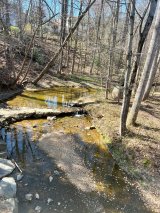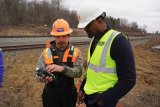Search Perspectives
Filter By:
Displaying 1 - 15 of 22 results
-

Lead in Private Well Water and its Impacts on Children's Health
There is no safe level of lead. Lead can be present in drinking water without any noticeable changes in color or odor. It is the responsibility of private well owners to test their water for lead and to take appropriate measures to mitigate exposure.
- Date:
- By: Sara Eaves
-

Acting Upstream for Creek and Community
A common threat to streams is runoff from heavy rains that cause floods, wearing away at riverbanks. Across the country, the Green Infrastructure program works with communities to address the effects of stormwater runoff through a variety of programs.
- Date:
- By: Jake Krauss
-

Kicking off 2024 With Twin Birthdays and Reasons to be Thankful
A toxicologist with the Safer Choice program finds a label in the place she needed it the most.
- Date:
- By: Lauren Duffy
-

A Silver Anniversary for the Gold Standard in Children's Environmental Health Protection
An overview of the work of PEHSUs, a network of pediatricians, nurses, health educators and other health professionals with special expertise in the prevention, diagnosis, management, and treatment of health issues that arise from environmental exposures.
- Date:
- By: Janet McCabe
-

The Biden-Harris Administration’s Commitment to the People of East Palestine is Unwavering
Within hours of the derailment, under President Biden’s leadership, his Administration, along with federal, state, and local officials, sprang into action. First responders from the EPA arrived on the scene—and we haven’t left since.
- Date:
- By: Michael Regan
-

Exploring Environmental Health Data Using An Interactive Data Visualization Application
Data visualization tools or apps help to visually display many years of information using more than just a static map, scatter plot or table.
- Date:
- By: Dr. Sala N. Senkayi
-

Protecting Children from Extreme Heat
With the arrival of long summer days spent outdoors in the heat, it is more important than ever to pay attention to extreme heat and children’s health.
- Date:
- By: Grace Robiou
-

Investing in America to Build a Brighter, Healthier Future
With unprecedented investments, we are moving further and faster than ever before to build a healthier and brighter future for our people and our planet.
- Date:
- By: Michael Regan
-

5 Ways EPA is Protecting People and the Planet
These past few months, EPA has moved further and faster than ever before to build a healthier and brighter future for all.
- Date:
- By: Michael Regan
-

Bringing a Local Stream Back to Life
When we start with clean water, we instantly reduce the amount of nutrients reaching larger bodies of water. Paddy Run may be small, but the smallest streams often have the biggest impact.
- Date:
- By: Christine Gonnelli
-

Revitalizing Water Infrastructure: Rolling toward safer water for communities
EPA’s WIFIA financing provides billions of dollars in credit assistance and creating local jobs while saving ratepayers and communities money. If you are interested in a WIFIA loan, you can submit a letter of interest to EPA at any time.
- Date:
- By: Jorianne Jernberg
-

Reducing Water Pollution from Power Plants
This action protects our nation’s vital water resources that support safe drinking water, agriculture, and healthy communities while providing greater certainty for industry.
- Date:
- By: Radhika Fox
-

Learning about water use in one of the driest states in America
Getting people to change their water use habits is more complicated than just putting up posters. There is clearly a major gap in water knowledge and action - raising awareness of water use concerns is the first step for a sustainable future.
- Date:
- By: Cameron Hodges
-

Inspiring Students to Tackle Environmental Challenges
Each change in habit, no matter how small, can make an impact. I wanted to make sure that our visit left an impression and helped encourage lasting change in the Earth’s youngest environmentalists.
- Date:
- By: KC Becker
-

Researching Improvements for Wastewater Lagoons in Small, Rural and Tribal Communities
Lagoons are mostly found in small, rural, and Tribal communities that face disproportionate environmental justice concerns. These are some of our most vulnerable communities and often low income or communities of color are disproportionally impacted.
- Date:
- By: Radhika Fox
